
Original Link: https://www.anandtech.com/show/2082
The NVIDIA GeForce 7900 GS: A Closer Look
by Josh Venning on September 19, 2006 5:00 AM EST- Posted in
- GPUs
Introduction
There has always been a lot of competition in the graphics card market between different card manufacturers, and also between ATI and NVIDIA in general. For each new board released by ATI or NVIDIA, another one pops up sooner or later from the other company as an answer. A lot of times the most notorious performance wars happen at the highest end, with ATI and NVIDIA trying to hold the coveted title for the "fastest card." We saw an example of this back when NVIDIA released their 7800 GTX much to the dismay of ATI, who had no direct competitor on the high-end for this card for a good while. This was one case where the clear winner in performance was NVIDIA on the high-end, but usually things aren't so cut and dry.
Of course, perhaps more importantly, competition also happens with cards around the $200-$300 mark, as these are the kind of prices most gamers are willing to spend for higher performance. Many die-hard and casual gamers have budget constraints but will gladly shell out $200 on a graphics card they know will give them significantly improved performance in a given game. This makes this price range important for graphics card companies to focus on, and we often see heavy competition in this area of the market.
NVIDIA's GeForce 7900 GS shipped recently without a lot of fanfare, but we are seeing lots of them available right now for about $200, which is right at NVIDIA's MSRP. This could be great news to a lot of gamers looking for a graphics card upgrade, provided the 7900 GS has the necessary performance capabilities. We recently took a look at how this card performs in relation to a number of cards from ATI and NVIDIA when it launched (here), and then we looked at its SLI performance in the more recent Fall '06 NVIDIA GPU Refresh - Part II: GeForce 7950 GT and SLI.
Today, we happen to have five of these cards from different hardware manufacturers, and as always we are interested in seeing just how they perform relative to each other as well as a few other cards on the market. Since NVIDIA's 7900 GS is an answer to ATI's X1900 GT, we'll of course be including this in our tests, as well as the X1800 GTO, 7800 GT, and 7900 GT. As it sometimes happens, all five of the 7900 GS cards we have for this review come factory clocked at different speeds, with only one of them (from Albatron) at reference speeds (i.e. not factory-overclocked; 450MHz/660MHz). This means we'll get a detailed view of what we can expect from this card out-of-the-box compared to its competitors.
It appears as though overclockability will be one of the interesting features of these cards and might ultimately be a primary selling point. Of course, we will do some overclocking of our own on these cards, as well as the usual power load and heat tests, to give a thorough evaluation of each of these cards. The price tag is always a factor when considering a graphics solution, so we will be breaking down the prices of these cards and taking into account their individual performance to determine their overall value for this review. These are the things we'll be keeping in mind as we look at these different 7900 GS offerings from EVGA, BFG, Leadtek, XFX, and Albatron. So without further ado, let's talk about the cards.
The Cards
We've recently looked at the NVIDIA GeForce 7900 GS and its architecture. To recap, the 7900 GS has identical clock speeds to the 7900 GT, but with one less vertex pipeline and four fewer pixel pipelines. NVIDIA intends for it to be a direct competitor to ATI's X1900 GT, but at reference speeds the 7900 GS doesn't quite perform as high as the X1900 GT. Overclocking may improve the situation somewhat as we'll see in the next section.
Here is a breakdown of the 7900 GS cards we have for this review along with their clock speeds and prices:
| GeForce 7900 GS Clock Speeds and Pricing | ||
| Manufacturer and Card | Factory Clock | Price |
| Albatron GeForce 7900 GS | 450/660 | *$200-$250 |
| XFX GeForce 7900 GS RoHS Extreme | 480/700 | $211 |
| EVGA e-GeForce 7900 GS | 500/690 | $216 |
| Leadtek Winfast PX7900 GS TDH Extreme | 520/700 | *$220 |
| BFG GeForce 7900 GS OC | 540/660 | $200 |
As sometimes happens, we weren't able to get prices for all of these cards at the time of this writing. The Albatron 7900 GS and the Leadtek PX7900 GS TDH Extreme are not yet available, but we've included the target street prices (marked by an asterisk) for these cards. The 7900 GS was predicted to retail at around $200, and just a few weeks after its release prices reflect this. We can't predict what the market will do, but hopefully prices for the 7900 GS will drop some in the coming months.
It's interesting that the 7900 GS card in this roundup that has the highest factory overclock is also (currently) the least expensive, and right away makes the BFG model stand out. We'll look at performance in a moment, but first let's take a closer look at the individual cards.
Albatron
The first 7900 GS we are looking at today is from Albatron.

This card looks like a standard reference 7900 GS, with a small heat sink and fan taking up little space on the board. The heat sink has the Albatron logo over a swirly blue and white background. Most of the 7900 GS cards we have for this review come with a factory overclock on the core, but our Albatron 7900 GS comes clocked at reference speeds (450/660).
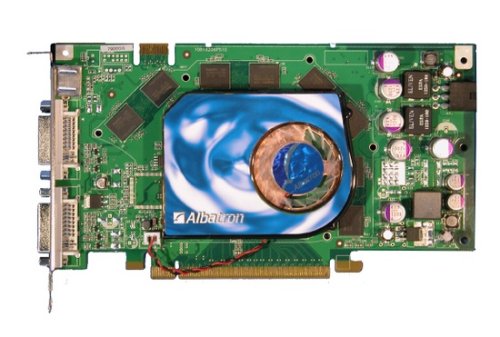
The card also comes bundled with the necessary adapters and cables, as well as one racing game: TOCA Race Driver 3. We aren't sure how good this game is, but it might be a nice bonus to Albatron's 7900 GS package. As of right now, we don't have a price for this card, but we should begin seeing it for sale on Newegg very soon.
Leadtek
The next 7900 GS we are looking at is from Leadtek, and it has a different heat sink design.

The heat sink and fan combo is a bit larger on this board than the reference 7900 GS, giving it the appearance of something similar to the 7800 GS. The design on the heatsink is simple, with the WinFast logo and the card name over a black heatsink with blue stripes across it. This card also comes with two games included in the bundle, Serious Sam 2 and Spellforce 2.
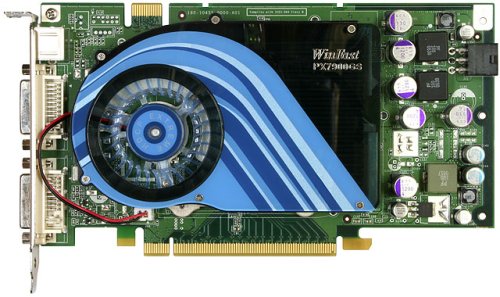
Something slightly unique about this 7900 GS is that it's one of the two cards we have for this review that has a factory overclock on the memory clock as well as the core. The extra 40MHz of memory speed (700MHz verses the standard 660MHz) won't really give this card a big edge in performance over the other cards in this review, but it's still a nice bonus all other things being equal. Depending on the game, the core clock speeds of a graphics card will usually have a larger impact on performance than the memory clock speeds.
EVGA
EVGA is a respected name in graphics hardware, and they sent us one of their 7900 GS models for this review.

Their 7900 GS has a slightly different heat sink design than the reference card, but it's not quite as different as the Leadtek 7900 GS.
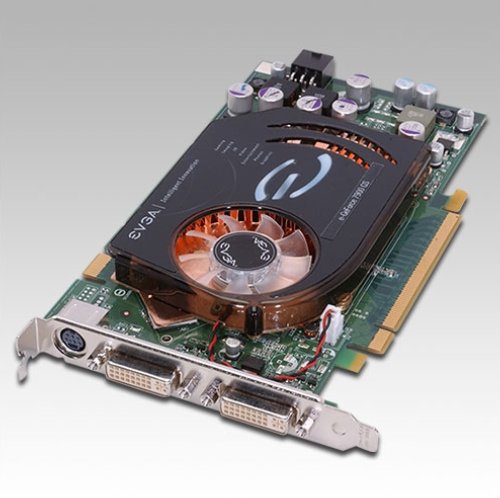
The EVGA 7900 GS's heat sink is slightly longer than the reference 7900 GS's heat sink and it has two gill-shaped cutouts exposing some copper ridges from the inside of the sink. Aside from that, the card has the signature EVGA black coloring, with their logo and card name in clear view on the face.
This card also comes with a game bundle. Hitman: Blood Money is included, and as an added bonus, when you register you are able to receive two additional games: Half-Life 2: Episode 1 and Dark Messiah of Might & Magic (while supplies last). This game bundle is definitely a welcome addition to the card.
BFG

Our fourth 7900 GS we have for this review is the BFG GeForce 7900 GS OC.
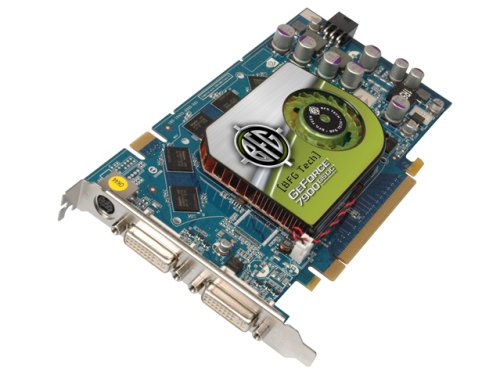
As the "OC" implies, the card comes out-of-the-box with a factory overclock, and it happens to have the highest core clock of all of our 7900 GS cards in this review. The BFG 7900 GS OC's core clock is set at 540MHz, a 90MHz increase over the standard NVIDIA 7900 GS, with the memory clock the same as the reference (660MHz). This is an impressive factory overclock, and we are interested to see what kind of performance we will see with this card. Unfortunately, no games are included in the BFG 7900 GS OC's bundle, but the fact that this card is factory overclocked so high as well as its low price more than make up this.
XFX
Finally, we also have a 7900 GS from XFX, the XFX GeForce 7900 GS RoHS Extreme.

This is the same XFX 7900 GS we looked at in the 7900 GS launch article, but we'll be delving a little deeper for this review.
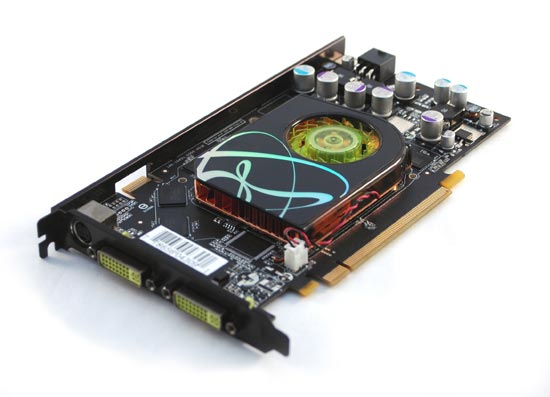
This 7900 GS has a sleek black look that is a little different than the colorful light-colored XFX cards we've seen in the past. The design is the same as the reference card, aside from the noticeable bar along the top with the XFX logo on it. We aren't sure why they designed the card this way, but it gives the card a unique look that sets it apart from our other 7900 GS cards. The XFX 7900 GS RoHS Extreme comes with a somewhat modest factory overclock (in spite of the "Extreme" label) of 480MHz on the core and 700MHz on the memory.
There are also no games included in the bundle for this card and it lists for about $211 right now, which is slightly higher than the factory overclocked BFG 7900 GS. Out of the box, the BFG looks to be a better deal, but as we will see in the overclocking section, this card could come out ahead with user overclocking.
Test Setup
We already had a look at how the 7900 GS performs relative to several other cards currently on the market from both ATI and NVIDIA. Today we will be looking at how well these individual 7900 GSs perform relative to each other, and we've thrown in a couple of other cards from NVIDIA and ATI for reference. From NVIDIA, we included the reference 7800 GT and the 7900 GT, and from ATI, the X1900 GT and the X1800 GTO.
We tested three different games at three different resolutions to give us a general idea of performance. The games we tested were Battlefield 2, Half-Life2:Episode One, and The Elder Scrolls IV: Oblivion. We tested each of these games at 1024x768, 1280x1024, and 1600x1200 with graphics quality settings on high in each game whenever possible.
This is the system we used for testing:
| CPU: | Intel Core 2 Extreme X6800 (2.93GHz/4MB) |
| Motherboard: | Intel D975XBX (LGA-775) ASUS P5NSLI |
| Chipset: | Intel 975X NVIDIA nForce 570 SLI |
| Chipset Drivers: | Intel 7.2.2.1007 (Intel) NVIDIA nForce 8.22 |
| Hard Disk: | Seagate 7200.7 160GB SATA |
| Memory: | Corsair XMS2 DDR2-800 4-4-4-12 (1GB x 2) |
| Video Card: | Various |
| Video Drivers: | ATI Catalyst 6.8 NVIDIA ForceWare 91.47 |
| Desktop Resolution: | 1920 x 1440 - 32-bit @ 60Hz |
| OS: | Windows XP Professional SP2 |
*Note that sound was disabled for testing.
Battlefield 2
We start our performance tests by looking at Battlefield 2, one of our standard game benchmarks. This benchmark is basically a running game demo following several players in different vehicles (including a jet) and on foot in third-person view. This gives us samples from different perspectives in the game and provides a good overview of the performance in Battlefield 2. Detail settings are on "High" for testing.
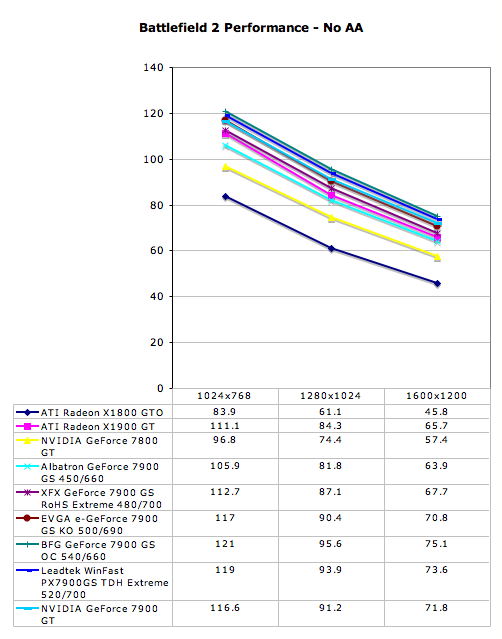
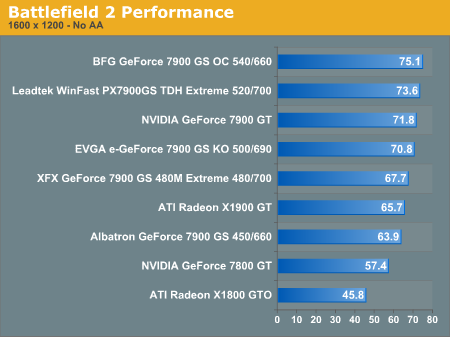
The five 7900 GS samples we have here offer a good representation of the performance potential this card has with different factory overclocks from card manufacturers. The "out of the box" performance of the 7900 GS will vary more or less depending on the game between different card versions. In Battlefield2, we see a significant difference between performance between the slowest 7900 GS (the Albatron GeForce 7900 GS) which is clocked at reference speeds, and the higher clocked BFG GeForce 7900 GS OC. At 1600x1200 resolution, there is a 17.5% framerate increase with the overclocked BFG 7900 GS, which could definitely be a noticeable improvement during gameplay.
Also, we can see how at reference speeds, the 7900 GS gets lower framerates than the reference 7900 GT, but most of our factory overclocked 7900 GS cards match or surpass the performance of the 7900 GT in each resolution. This is important considering that the 7900 GT generally costs around $100 more than the 7900 GS. Keep in mind however, that the 7900 GT has potential for overclocking as well, and its performance potential will exceed that of the 7900 GS depending on the specific card and application.
Something else we see that is particularly noteworthy here and in the other game tests is how ATI's X1900 GT compares to these 7900 GS cards in performance. The 7900 GS at reference speeds doesn't perform as well as the X1900 GT; for example, at 1024x768 the Albatron 7900 GS gets a framerate of 105.9 FPS verses the X1900 GT's 111.1 FPS. But as we saw in the previous example, our Leadtek and BFG 7900 GS samples get higher performance with their factory overclocks, which is of interest given these cards are in direct competition with each other.
Half-Life 2: Episode One
Half-Life 2: Episode One is another standard game benchmark we use to test our GPUs. The engine has been around for a while, but Valve has been adding things like bloom and HDR effects to give the graphics new life. One thing we like about HL2:E1 is that it gets very good framerates across a wide range of cards, which isn't very common among games of this caliber. For testing we set the detail settings to "high" in the graphics settings for this game. Water detail is set to "Reflect All," and High Dynamic Range is set to "Full (if available)."
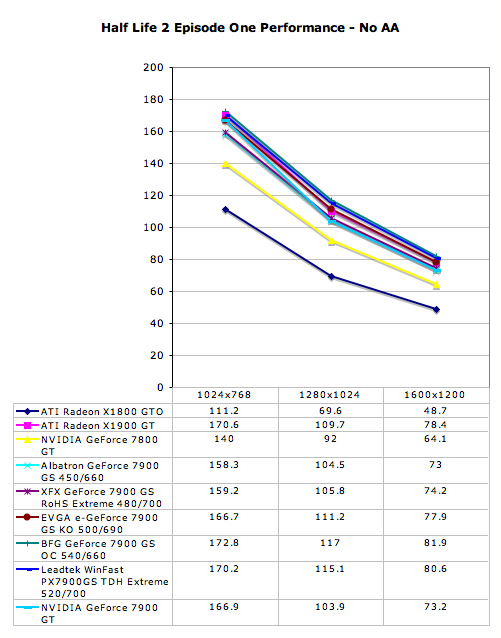
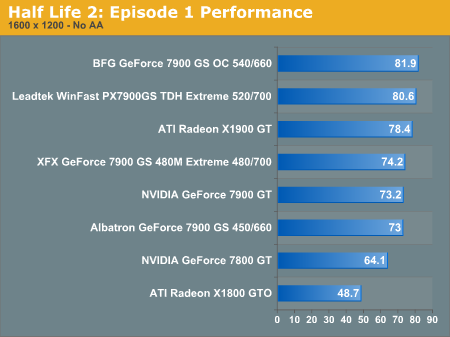
Here we again see a significant increase in performance between the Albatron 7900 GS and the BFG and Leadtek cards. We can also compare the performance of the X1900 GT and the different 7900 GS cards and see again how the two fastest 7900 GS cards perform slightly better than the X1900 GT. We can also see that there isn't much difference in performance at all between the 7900 GT and the reference clocked Albatron 7900 GS, which is further evidence that the 7900 GS could be considered the better value card of the two, depending on price.
The Elder Scrolls IV: Oblivion
Our third and final benchmark is from The Elder Scrolls IV: Oblivion. This is a fairly recent game which boasts some of the most advanced graphics of any game available to date. Oblivion is one of the most beautiful games we've ever played, and unfortunately it is also one of the most graphically demanding. It can easily put a huge strain on most graphics cards when quality settings are turned up.
We mentioned recently in our silent GPU review that we don't recommend playing Oblivion on a budget or low/midrange graphics card, and we stand by this statement. The game loses a lot of playability without things like Distand Land turned on. This is why we test the game with higher quality settings enabled. Here are the quality settings we used for these test.
| Oblivion Performance Settings | |
| Texture Size | Large |
| Tree Fade | 100% |
| Actor Fade | 100% |
| Item Fade | 66% |
| Object Fade | 90% |
| Grass Distance | 50% |
| View Distance | 100% |
| Distant Land | On |
| Distant Buildings | On |
| Distant Trees | On |
| Interior Shadows | 95% |
| Exterior Shadows | 85% |
| Self Shadows | On |
| Shadows on Grass | On |
| Tree Canopy Shadows | On |
| Shadow Filtering | High |
| Specular Distance | 100% |
| HDR Lighting | On |
| Bloom Lighting | Off |
| Water Detail | High |
| Water Reflections | On |
| Water Ripples | On |
| Window Reflections | On |
| Blood Decals | High |
| Anti-aliasing | Off |
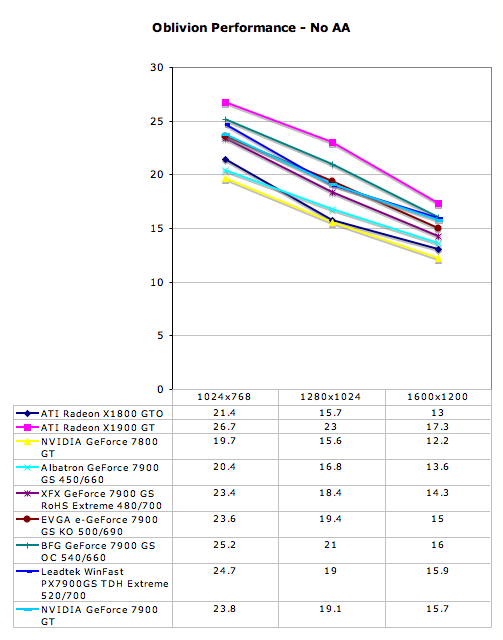
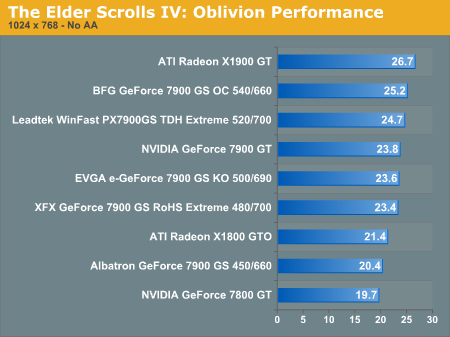
For this benchmark, we use FRAPS to measure the average FPS while walking towards an Oblivion gate at night. The margin of error is about 5% for each card, so smaller differences can be ignored. This is one of the more graphically intensive benchmarks we have for this game, and that's why we see such low framerates across the board, even among the faster cards.
This is a game where having a higher clocked 7900 GS is really ideal over a lower clocked one like the Albatron 7900 GS. With a framerate of 25.2 FPS at 1024x768 (which is a very playable resolution for this game), the BFG 7900 GS OC offers much better performance than the 20.4 FPS we see from the Albatron 7900 GS. Considering this, we would recommend either the overclocked BFG or Leadtek 7900 GS to anyone interested in a 7900 GS for playing Oblivion.
Also, because this game tends to favor ATI hardware over NVIDIA, we see that this is one case where the X1900 GT beats out all of the 7900 GS cards in performance in spite of their factory overclocks. If Oblivion is your game of choice and you are looking for a graphics upgrade at around the $200 range, the Connect3D Radeon X1900 GT is available at the time of this writing for $220 and is a good option.
Overclocking
As we mentioned in the introduction, and as we've seen in our performance tests, something to note with the 7900 GS is that it seems to be fairly good at overclocking. This is a factor that could potentially make the 7900 GS a formidable competitor to other cards in its price-range. Most of our 7900 GS's in this roundup have factory overclocks, but many users are interested in doing their own overclocking, so with this in mind, we've done some overclocking on these cards ourselves.
To get our overclocks, we use a method of gradually bumping up the clock speeds using coolbits, and then stress-testing the cards (using game benchmarks) to ensure stable operation at the highest possible clock speeds. "Stable Operation" is basically when a game benchmark runs without any tearing or graphical artifacts due to heat, and also without any lowered performance.
Every graphics card overclocks differently, and it's important to take some precautions when doing your own overclocking to avoid damaging your card. The speeds we achieved here do not necessarily reflect the exact overclock another XFX or EVGA 7900 GS owner might be able to achieve.
| GeForce 7900 GS Overclocking | ||
| Manufacturer and Card | Factory Clock | User Overclock |
| Albatron GeForce 7900 GS | 450/660 | 524/800 |
| XFX GeForce 7900 GS RoHS Extreme | 480/700 | 597/824 |
| EVGA e-GeForce 7900 GS KO | 500/690 | 591/812 |
| Leadtek Winfast PX7900 GS TDH Extreme | 520/700 | 556/790 |
| BFG GeForce 7900 GS OC | 540/660 | 571/751 |
The XFX 7900 GS was one of our cards that overclocked especially well, along with the EVGA 7900 GS KO. Two of our 7900 GS cards that came with fairly modest factory overclocks managed to achieve higher user overclocks than the others. Unfortunately, the card with the lowest factory clock, the Albatron 7900 GS, also got the lowest user overclock, which is something of a drawback for this particular card. Below are the performance results at these clock speeds.
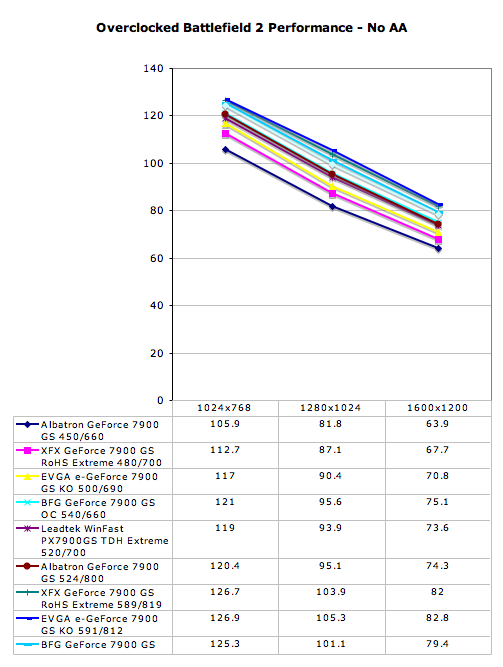
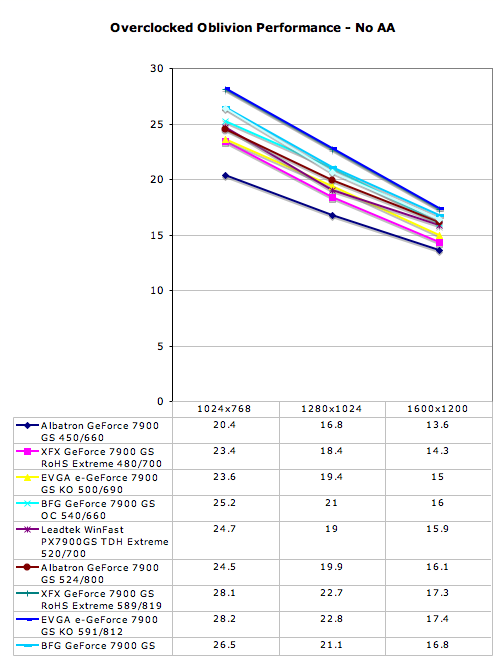
The data here shows the kind of improved performance these cards are capable of with further overclocking beyond the factory clocks. As expected, performance was the highest with the overclocked XFX and EVGA 7900 GS cards, and the improvements in framerates are impressive. In Oblivion for example, between the reference clocked Albatron 7900 GS and our user overclocked EVGA 7900 GS (591/812) at 1024x768, there is a 38% increase in performance. This kind of performance increase can mean the difference between being able to play at a higher resolution or with the quality settings turned up a little higher.
Even though the Albatron 7900 GS wasn't able to get as high of an overclock as the others, as the data shows, it still performs higher than most of the stock factory overclocked cards. Still, because there seems to be such variation between theses cards' overclocking ability, choosing the XFX or EVGA 7900 GS over the Albatron might be the best option if you plan to do your own overclocking. As we only have one sample of each card, we can't say for sure whether or not customers will be able match our overclocks or even exceed them, and as the saying goes your mileage may vary.
Power
Power draw is also an important factor when evaluating a graphics solution. For a card that performs or overclocks well, it can be a big drawback if the card draws a lot of extra power, especially for those running SLI setups. We test power by measuring the total wattage of the system with each card installed in two different states. The first state is while the system is idle, without any programs running, and the second state is under load, by running a graphically intensive benchmark. The benchmark we used to stress the graphics cards was 3DMark06, specifically, the fill rate (single and multi-texturing) and the pixel shader tests.
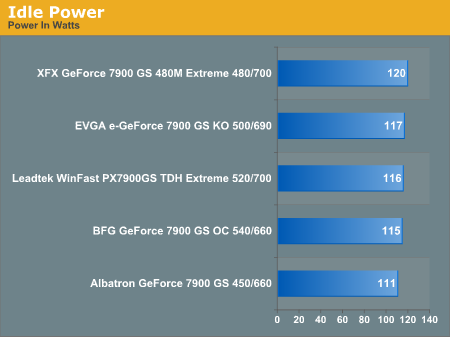
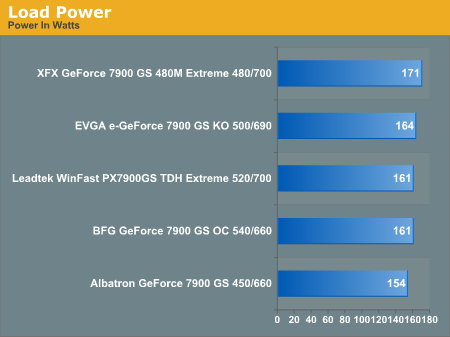
The first thing we notice here is that the XFX GeForce 7900 GS RoHS Extreme is the most power-hungry card while the system is both idle and under load. Under load, the difference is more pronounced, and the system draws about seven more watts than the card with the second highest power draw. This could be a bit of a problem for those interested in overclocking it themselves. A card with this kind of power draw will most likely get hotter and put more of a strain on your power supply while being overclocked. Conversely, the Albatron 7900 GS draws the least amount of power at both states, which makes sense considering its low clock speeds.
What is a little strange and could be seen as a plus for this card, is that the BFG 7900 GS OC, our highest-clocked 7900 GS, got the second lowest score in our power tests at both idle and load states. However, it was almost exactly tied with the Leadtek WinFast PX7900 GS TDH Extreme, which was our second-highest factory clock card. This is a bonus for both of these cards.
Heat
Similar to the way we tested power consumption, we measured the heat level of the cards in two different states: idle and after five minutes of stress testing. In order to stress test the card, we made use of ATI Tool's "Scan for Artifacts" function on their "fuzzy cube" 3D view. This feature basically works by drawing a 3D cube with some kind of fuzz map over and over and about five minutes of "scanning" with this tool gives us the same kind of heat reading we typically get from a period of extended gameplay.
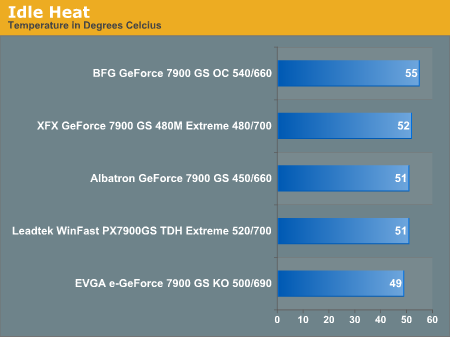
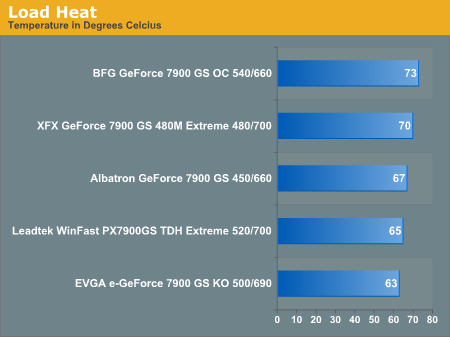
Here we see that the factory overclocked BFG GeForce 7900 GS OC generates the most heat of the five, which isn't too surprising given its level of performance. Interestingly, there doesn't seem to be much correlation between power loads and heat levels for these cards, as our numbers show. The coolest-running 7900 GS we have is the EVGA e-GeForce 7900 GS KO, which might make it the 7900 GS of choice for those concerned about heat levels because of their climate or case circulation. Something notable here is that the Leadtek PX9700 GS TDH Extreme gets a fairly low heat score in our tests in spite of having one of the higher factory overclocks.
Lower temperatures can also mean better overclocking potential, which may explain the higher overclock we got with the EVGA card. Overclockers also know that adding more voltage can improve stability when overclocking - whether it be for CPUs, GPUs, or memory - and that might explain the higher power draw of the XFX card.
Final Words
To recap, we've seen the kind of impact on performance the different factory overclocks can make with these cards. The BFG 7900 GS OC and Leadtek PX7900 GS TDH Extreme in particular do much better than the reference clocked Albatron 7900 GS, with the BFG performing the best by a slight amount in all of the tests. After our Leadtek 7900 GS, The EVGA e-GeForce 7900 GS KO performed slightly better than the XFX 7900 GS Extreme, with the Albatron 7900 GS at the bottom in terms of performance. As we've mentioned already, the core clock speeds will usually have a more significant impact on performance than the memory clock speeds, which explains how the overclocked BFG 7900 GS performs so much better than the others without any overclock on the memory clock.
We also saw that the BFG 7900 GS OC outperformed the X1900 GT in most of our tests with its high factory overclock. The fact that the 7900 GS is NVIDIA's competition to the X1900 GT makes this finding significant, especially when you consider the price difference between these two cards. At the time of this writing, the BFG 7900 GS OC is available for $200, and since the lowest price for the X1900 GT is around $220, this would make the 7900 GS a little more desirable to the average buyer. ATI does hold a clear lead with the X1900 GT in Oblivion performance, however, and as we saw in our 7900 GS overview it also leads in Quake 4.
We've also seen that by user-overclocking the 7900 GS, we can get a much higher level of performance out of these cards. This is something that will potentially make the card more desirable to gamers who are interested in overclocking their GPUs. The XFX 7900 GS RoHS Extreme and the EVGA 7900 GS KO in particular got very high overclocks, resulting in significant performance increases in Oblivion and Battlefield 2.
Something else we want to touch on is HDCP capabilities with these cards. This is something that may not be a vital feature for many users at this time, but support for HDCP will become more important for those interested in using their PCs to watch protected content in the near future. Of the five 7900 GS cards in this review, only two of them do not support HDCP at this time: the XFX 7900 GS RoHS Extreme and the BFG 7900 GS OC. This might be an important factor for many potential buyers looking for a 7900 GS that is right for them.
For reference, here is an overview of the cards and their respective factory clocks, our user overclocks, prices, and whether or not they support HDCP.
| GeForce 7900 GS Overview | ||||
| Manufacturer and Card | Factory Clock | User Overclock | Price | HDCP |
| Albatron GeForce 7900 GS | 450/660 | 524/800 | N/A | Yes |
| XFX GeForce 7900 GS RoHS Extreme | 480/700 | 597/824 | $211 | No |
| EVGA e-GeForce 7900 GS KO | 500/690 | 591/812 | $216 | Yes |
| Leadtek Winfast PX7900 GS TDH Extreme | 520/700 | 556/790 | $220 (MSRP) | Yes |
| BFG GeForce 7900 GS OC | 540/660 | 571/751 | $200 | No |
Taking into consideration performance and price, there is little debate that the BFG GeForce 7900 GS OC at $200 is the best choice out of the five 7900 GS cards we have for this review. It is not only the least expensive 7900 GS (out of the reviewed cards) currently on the market, but it happens to have the highest factory overclock as well. It has two drawbacks however in that it doesn't come with any games and also it does not support HDCP. Given the sheer performance potential of this card however we still would recommend it over the others.
We don't know the price yet, but unless the price for the Albatron GeForce 7900 GS is exceptionally low (say around $180) we wouldn't recommend buying this card. The bundled TOCA Race Driver 3 game might make this package more appealing for a few, but we found that this card was the worst in both out-of-the-box and user-overclocking performance.
For those in the market for a 7900 GS who want HDCP support, a very nice factory overclock, and a couple of games included in the bundle, keep a lookout for the Leadtek WinFast PX7900 GS TDH Extreme. This will hopefully be on shelves soon for around the MSRP of $220. The EVGA e-GeForce 7900 GS KO would be a good choice for those who want HDCP support, a couple of games (including Hitman: Blood Money), and an exceptional warranty policy (EVGA will replace your card for any reason aside from deliberate physical damage; even if you break it while overclocking). The XFX GeForce 7900 GS RoHS Extreme at $211 is a decent price, and it's overclocking potential is noteworthy, but like the BFG you don't get any support for HDCP or any games included in the bundle.
If you need a 7900 GS right now (and don't care about HDCP support), grab the factory-overclocked BFG 7900 GS CO for $200. If you aren't in a big hurry, the Leadtek WinFast PX7900 GS TDH Extreme looks like it might be a great option if it hits the market soon and at the suggested price of around $220. These are our current picks out of the 7900 GS cards on the market, but hopefully we'll be able to look at some more manufacturers' versions of NVIDIA's 7900 GS sometime soon.







